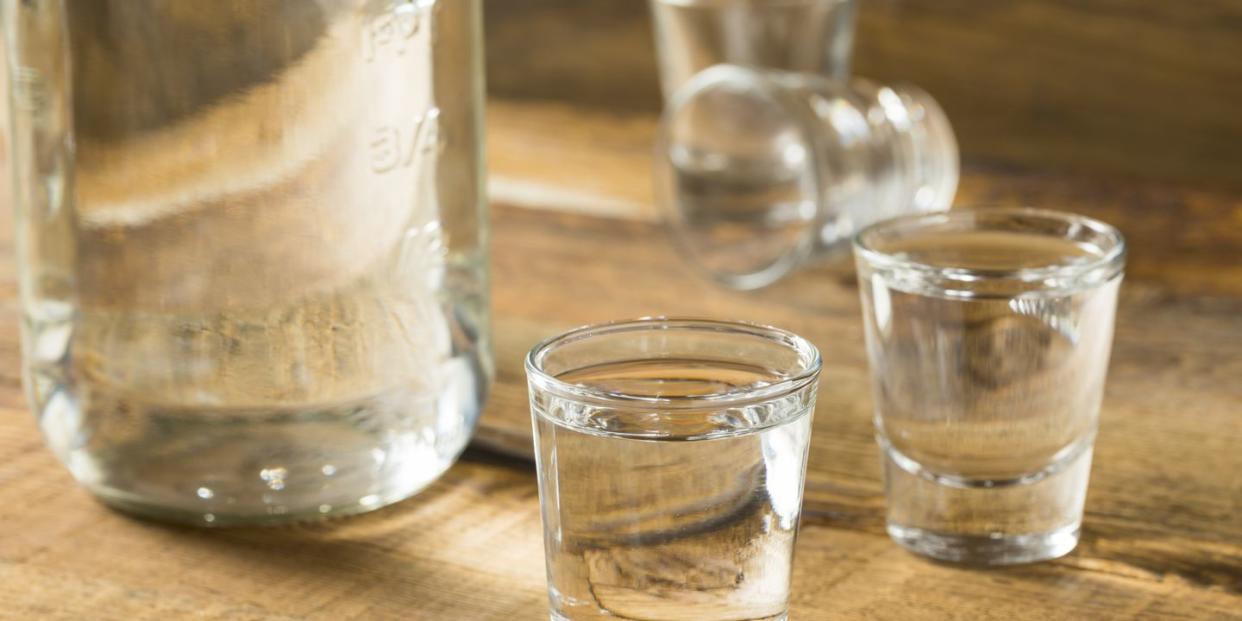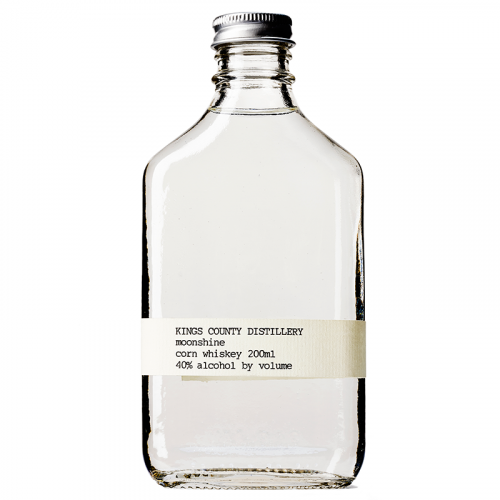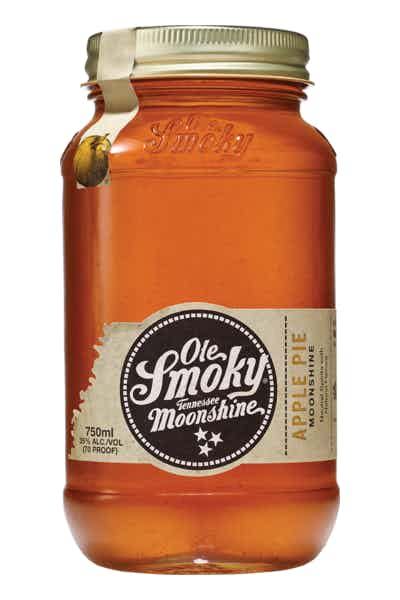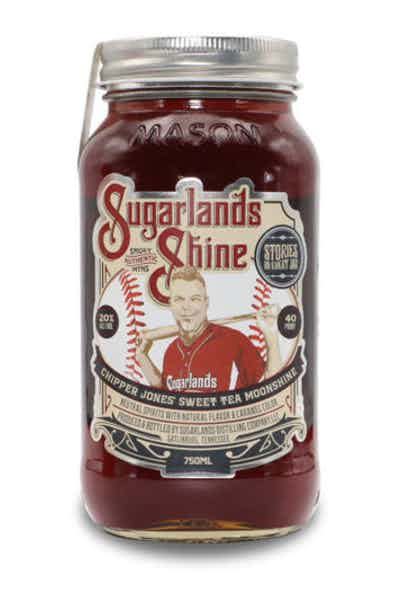Moonshine Is Still Illegal FYI—Technically Speaking

"Hearst Magazines and Yahoo may earn commission or revenue on some items through these links."
When you were learning about Prohibition in your high school history class, you probably heard a few things about moonshine. The spirit has also been colloquially named rot gut, white lightning, and hooch. And those are just a few of its many nicknames—some more derogatory than others.
Beyond its reputation as booze that's produced illegally, moonshine is largely known for its high alcohol percentage. It also gets a bad rap for being produced at home, with many believing the product is inferior or dangerous compared to commercially made spirits.
But moonshine is actually part of a longstanding tradition of home distilling that dates back centuries. And while some people primarily associate it with Prohibition, it’s still being made to this day. We’re here to break down the history of moonshine, dispel any misconceptions about the spirit, and recommend the best brands to try for yourself.
What Is Moonshine?
Historically speaking, moonshine is an umbrella term for any type of alcohol made and distributed without legal authorization. The name itself is believed to come from the Scottish highlands, where whisky makers would transport their liquor illegally in the middle of the night by the light of the moon.
In the 18th century, Scots-Irish settlers planted their roots in Appalachia, along the western outskirts of colonial territory. They brought with them their whisky-making traditions, then adapted them to incorporate North American agriculture, namely corn.
An article by Emelie K. Peine and Kai A. Schafft in the Journal of Appalachian Studies unpacks the cultural significance of the booze’s European roots. They write, "The migrants brought with them not only their tradition of whiskey making, but a desire to escape a repressive state structure."
So naturally, once the newly formed United States started implemented legal obstacles for moonshiners, they fought back and found other ways to skirt the law. Liquor taxes began as early as 1791 and caused the famous Whiskey Rebellion in western Pennsylvania. To avoid the extra costs associated with licensure, taxes, and other regulations, moonshining soon became a clandestine operation and earned its reputation as the bad boy of booze.
That became especially true with the advent of the temperance movement in the United States. The movement to limit alcohol consumption caused states to start banning spirits as early as 1910, before nationwide Prohibition was enacted ten years later. And while commercial alcohol production was stifled, the business of making and bootlegging moonshine boomed.
With Prohibition long over, people can pick up a bottle of whiskey legally without spending a ton of money. Because of this, moonshine production has dwindled significantly—but not entirely.
Is Moonshine Actually Dangerous?
Just like pretty much any food product made at home, moonshine comes with some inherent risks if distilled improperly. Canning food can sometimes cause botulism, not taking care of your sourdough starter can introduce some dangerous bacteria, and distilling any kind of alcohol creates varying quantities of methanol.
Unlike ethanol, methanol is an undesired alcohol byproduct of the distillation process. It’s used to make fuel for vehicles and antifreeze. And in large enough quantities, it can pose serious health hazards and even cause blindness. Commercial distilleries have safety guidelines and testing mechanisms to limit the amount of methanol produced in their liquor. But moonshiners do not have that infrastructure—so there is significantly more risk for consumers.
Other big risk factors are the materials used to make the homemade stills. Back in the Prohibition era, many moonshiners would use lead-based car radiators to make their booze, which could be poisonous. Knowledge surrounding lead poisoning is much more widespread today, but unsafe production methods still occur around the world.
What Does Moonshine Taste Like?
Just like any other type of alcohol, it depends on the recipe. But while many regulated spirits (think bourbon and scotch) have stringent rules for the ingredients and techniques, moonshine is like the Wild West of liquor. While corn is often the primary grain, you can find recipes that use barley and rye. The ratios of those grains, the way it’s distilled, how long it’s aged, and any added flavorings all impact the overall flavor.
One common thread between all types of moonshine is that it’s strong. Many compare the flavor to rubbing alcohol or Bacardi 151. Depending on the recipe, your moonshine can range from anywhere between 40-80% ABV.
Is Moonshine Still Illegal?
Yes, it is. And unless the United States entirely stops regulating the alcohol industry, moonshine will always be illegal. But in Appalachia, where American moonshining is most common, it’s largely accepted as a longstanding cultural tradition. Those who still distill moonshine in the region are not actively sought out by law enforcement necessarily. In Cocke County, Tennessee, the writers Peine and Schafft say, “While moonshining is illegal, it is not locally perceived, at least by most, as criminal.”
But, unfortunately, getting access to “authentic” moonshine is typically limited to locals and those with insider knowledge. And for anyone who isn't in the know and wants to try commercially produced moonshine, several distilleries across the country are replicating the style legally. Brands like Ole Smoky and Sugarlands actually use the same recipes passed down by real moonshiners—they just abide by legal guidelines.
What Can You Make With Moonshine?
Anything! Unflavored and unaged moonshine varieties can act as a stand in for base liquors like tequila or vodka. So you can use them in pretty much every cocktail you can think of. But make sure to consider the alcohol percentage on the label before you drink—it’ll probably give you a bigger buzz.
Ready to give it a try? Here are some of our favorite (and legal!) moonshine brands that are a great place to start:

Kings County Corn Moonshine Whiskey
$23.99
caskers.com

Ole Smoky Apple Pie Moonshine
$23.99
drizly.com

Sugarlands Chipper Jones' Sweet Tea Moonshine
$22.99
drizly.com
You Might Also Like

